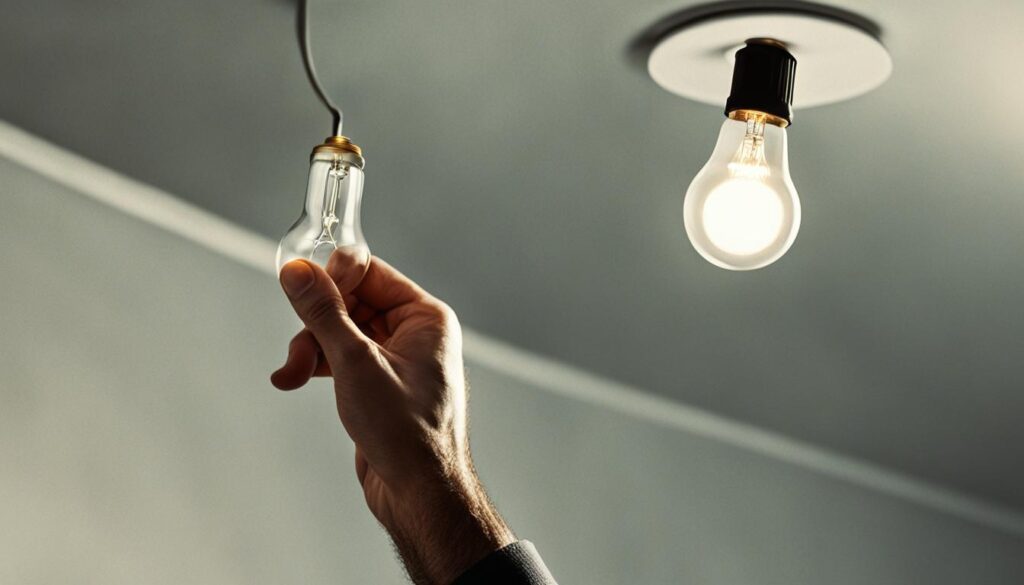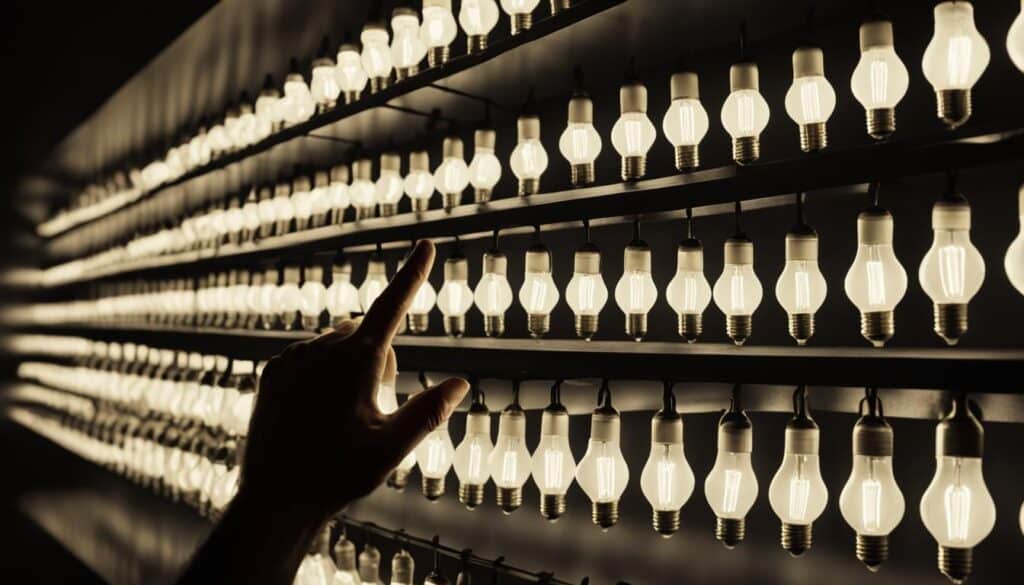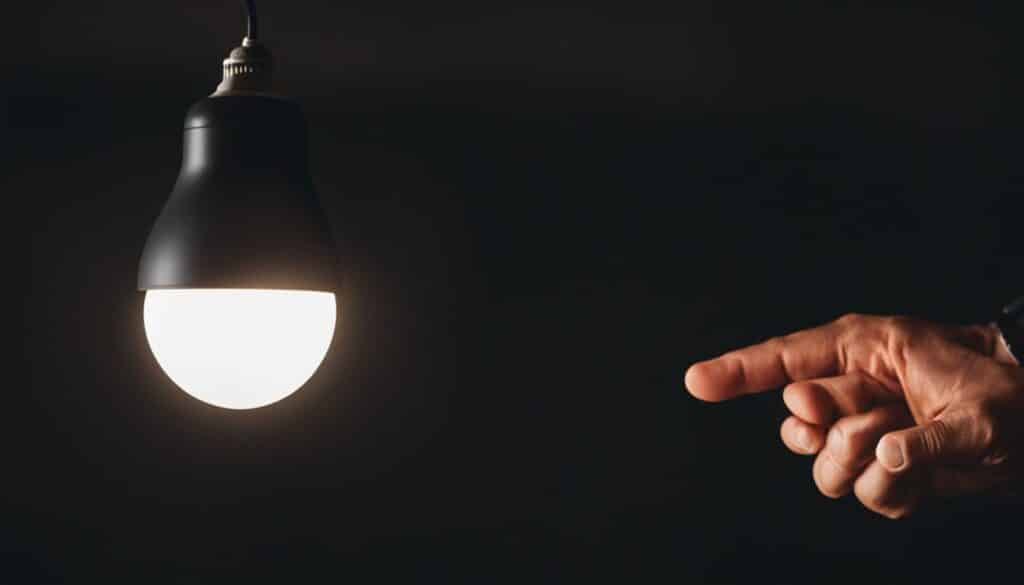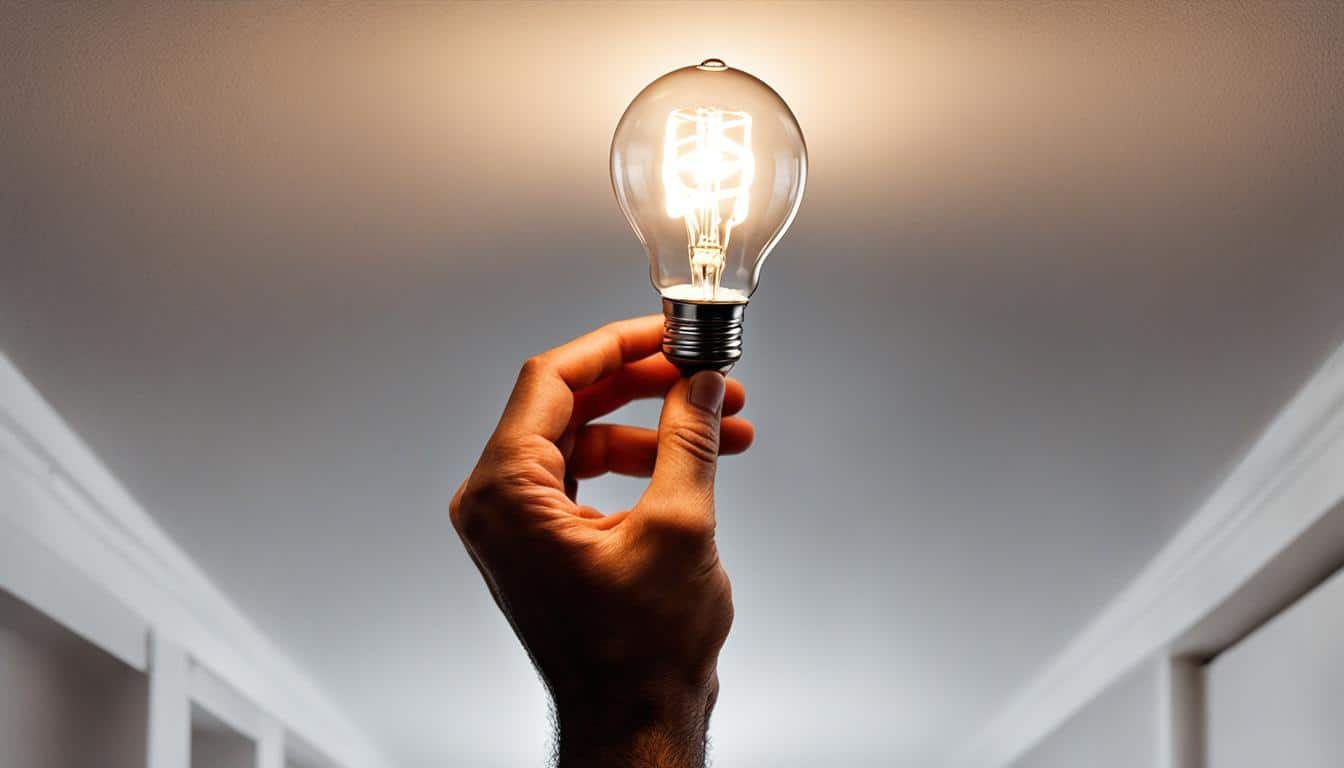Replacing a track lighting bulb is a breeze with our straightforward, easy-to-follow guide on DIY track lighting bulb replacement. Whether you’re a beginner or an experienced DIYer, this handy guide offers step-by-step instructions on track lighting bulb removal and installation. So let’s get started and learn how to replace track lighting bulb in no time!
Key Takeaways
- Ensure the light is turned off before attempting track lighting bulb removal.
- Allow incandescent or halogen bulbs to cool before handling them.
- Determine the correct type and wattage of the replacement bulb for your track lighting system.
- Gather all necessary tools, such as screwdrivers, gloves, and a sturdy ladder, before starting the replacement process.
- Follow proper installation techniques for different types of bulbs, ensuring a secure connection.
- Test the newly installed bulb and perform regular maintenance for long-lasting track lighting performance.
- Dispose of old bulbs responsibly and safely, following local disposal regulations and recycling options.
Understanding Track Lighting Basics
Track lighting is a versatile lighting solution that can be adapted to various environments and purposes. In this track lighting bulb replacement guide, we will explore the fundamental aspects of track lighting systems, including the components involved and different types of track lighting bulbs. This knowledge will help you in successfully changing track lighting bulb when necessary.
The Components of a Track Lighting System
A track lighting system comprises several key components working together to provide a customizable and flexible lighting solution. Some crucial track lighting system components are:
- Track: The linear structure that holds the electrical wiring and supports the individual fixtures.
- Fixtures: The lighting units that house the bulbs and can be adjusted along the track, rotated, or sometimes removed for easier bulb replacement.
- Transformer: This component converts the line voltage to a lower voltage required by certain types of bulbs, thus ensuring safe and proper operation.
- Connectors: These parts join multiple tracks to form a continuous lighting system, allowing for custom layouts and configurations.
When considering bulb replacement, you may need to loosen set screws, pins, or locking rings on the fixture. The fixture is then typically turned counter-clockwise for removal, allowing easy access to the bulb.
Types of Track Lighting Bulbs
Understanding the various types of track lighting bulbs is essential for successful replacement and installation. The most common types of bulbs used in track lighting systems include:
- Incandescent: Traditional incandescent bulbs are the most basic option, providing warm light and working with a simple screw-in mechanism.
- Halogen: These bulbs offer a brighter and more intense light output than incandescents but use more energy and can become extremely hot.
- Compact Fluorescent (CFL): CFL bulbs are more energy-efficient than incandescent or halogen bulbs but may not be dimmable, depending on the specific model.
- LED: The most energy-efficient option, LED bulbs have a longer lifespan, produce less heat, and are available in various sizes and shapes to suit different fixtures.
Each bulb type may require different methods for removal and installation. For example, LED models could involve a different mechanism than a traditional screw-in incandescent bulb. Therefore, it is crucial to understand the bulb type and the fixture’s specifications to ensure seamless replacement.
Preparation: Safety Measures and Tools Required
Before diving into the steps to replace a track lighting bulb, it’s essential to take the proper safety precautions and gather the necessary tools for a seamless and safe replacement process. By implementing track lighting bulb replacement safety measures, you’ll mitigate the risk of accidents and ensure a stress-free experience.
Turning Off the Power Correctly
First and foremost, turn off the track lighting system to avoid the risk of electrical shock or burns. Inform everyone in the room not to touch the light switch during the replacement process. If you’re working with incandescent or halogen bulbs, wait for at least 5-10 minutes after turning off the light for them to cool down. LED bulbs don’t generate much heat, so they can be handled immediately after switching off the light.
Gathering Essential Tools for Bulb Replacement
Having the right track lighting tools on hand will make the bulb replacement process easier and more efficient. Here’s a list of items you may need:
- Screwdriver
- Gloves (especially for handling halogen bulbs)
- Sturdy ladder or step stool

Equipped with these tools and safety measures, you’re now ready to follow the steps to replace track lighting bulbs both effectively and securely. Always remember that safety comes first during any DIY project!
Identifying Bulb Type and Track Lighting Specifications
When considering a bulb replacement for your track lighting system, it is crucial to identify the track lighting bulb type being used and the track lighting specifications of the light system. The light socket will typically have a label indicating the maximum wattage bulb that can be safely used without posing a fire hazard or causing a malfunction. Additionally, consulting the installation instructions that came with the light fixture can be very helpful in determining the proper type of bulb required for your specific track lighting system.
Consider the following steps to identify the bulb type and track lighting specifications:
- Examine the light socket for a label detailing the maximum wattage.
- Refer to the installation instructions provided with the light fixture.
- Check the base of the existing bulb for markings that indicate the bulb type and wattage.
- If you are still unsure, consult the manufacturer or a lighting professional.
Understanding the specific bulb type and track lighting specifications will assist in ensuring that the replacement bulb is compatible with the light fixture and adheres to all safety requirements. Identifying these conventions is an essential first step before purchasing and installing a new track lighting bulb.
How to Replace Track Lighting Bulb
Replacing a track lighting bulb is a simple process that can be done with a few simple steps. The specific process might vary slightly depending on the type of bulb being used, but the general approach remains the same. The following steps will guide you through the process of track lighting bulb replacement:
- Turn off the track light and disconnect it from the power source, ensuring safety while handling the bulb.
- Identify the type of bulb that is currently installed and the appropriate method for its removal.
- Carefully remove the old bulb from the socket, taking care not to damage it or any connecting components.
- Insert the new track lighting bulb into the socket, aligning it as needed.
- Secure the new bulb in place, taking care not to over-tighten it and cause damage or breakage.
- Reconnect the track light, then switch it on to test the functionality of the newly installed bulb.
The considerations and requirements for each bulb type might vary, so it’s essential to be familiar with the specifics of your bulb before attempting a replacement. For instance, when replacing quartz halogen bulbs, it’s crucial to avoid touching the surface of the bulb with your bare hands; oils from your skin can cause the bulb to fail prematurely. Wearing gloves or using a clean cloth is recommended when handling these types of bulbs.

| Type of Bulb | Removal Method | Installation Method |
|---|---|---|
| Incandescent or Halogen | Unscrew counter-clockwise | Screw in clockwise |
| LED | Unplug or twist depending on the connector type | Plug or twist in the opposite direction of removal |
| Quartz Halogen | Twist-and-lock removal while wearing gloves | Twist-and-lock installation while wearing gloves |
In conclusion, understanding how to replace track lighting bulbs effectively ensures a well-lit space and prolongs the life of your track lighting system. Acquaint yourself with the specific requirements of your bulb type and follow the appropriate steps for a seamless and safe replacement process.
Removing the Old Track Lighting Bulb
Before you can install a new track lighting bulb, it is important to safely remove the old bulb. The removal process will differ depending on the type of bulb you have. Whether working with incandescent, halogen, or LED track lighting bulbs, following the correct steps can ensure proper removal and prevent any damage.
Steps for Incandescent or Halogen Bulb Removal
Traditional incandescent and halogen bulbs can be typically removed by unscrewing them counter-clockwise. Be sure to let the bulbs cool down for at least 5-10 minutes after switching off the lights to avoid burns from the hot surface. Here are some steps to follow:
- Switch off the track light and wait for the bulb to cool down.
- Wear gloves to protect your hands while handling the bulb.
- Grip the bulb gently and twist it counter-clockwise until it is completely unscrewed.
- Once unscrewed, gently pull out the bulb to avoid any breakage.
Tips for Safely Handling LED Track Lighting Bulbs
When removing LED track lighting bulbs, it is crucial to handle them with care to prevent damage. Unlike incandescent and halogen bulbs, LEDs remain cool and can be handled immediately after switching off the light. Follow these steps to safely remove your LED track lighting bulb:
- Switch off the track light before removing the bulb.
- Gently grip the LED bulb, taking note of any specific notches or parts to facilitate proper removal.
- If the bulb has a unique design requiring unplugging or twisting, refer to the manufacturer’s instructions to ensure correct removal procedures.
- Gently pull out the bulb, being mindful of any delicate parts.
In cases where the method of removal is not clear, always revert to the manufacturer’s instructions or consult an expert to avoid any damage to your track lighting system. Safety and correct procedures should be prioritized to make your track lighting bulb removal process as smooth as possible.
Selecting the Right Replacement Bulb

When it comes to selecting track lighting replacement bulbs, one must invest time in researching the perfect match. It is often easiest to purchase the exact same model as the one that burned out, ensuring proper fit and compatibility with the existing track lighting system.
Bringing the old bulb to the store can significantly help in identifying an appropriate replacement with matching shape and connecting parts. This way, you can be confident in your track lighting bulb purchase and minimize the chances of buying the wrong product.
If there is already a supply of bulbs at home, double-check the compatibility with the burned-out model before using one of them. Look for labeling and specification details on the package or bulb itself for assistance in determining if the spare bulb is a match.
In conclusion, being diligent while selecting track lighting replacement bulbs can save time, effort, and prevent potential issues with your lighting system.
Maximizing Efficiency with Energy-Efficient Track Bulbs
With the advancement in lighting technology, energy-efficient options are widely available that can help reduce energy consumption without compromising the quality of light. One such option is energy-efficient track lighting bulbs, which use less energy and often produce less heat. Upgrading to these bulbs can significantly contribute to your energy-saving goals and create an eco-friendly lighting solution.
Benefits of LED over Halogen Track Bulbs
LED (Light Emitting Diode) technology is considered one of the most energy-efficient and durable options for track lighting systems. When compared to traditional halogen bulbs, LEDs have several advantages:
- Longer lifespan: LED bulbs tend to last up to 50,000 hours, significantly outlasting halogen bulbs, which average 2,000 hours.
- Reduced energy consumption: LEDs use 75% less energy than halogen bulbs, resulting in significant cost savings on energy bills.
- Minimal heat production: Unlike halogen bulbs, which produce a substantial amount of heat, LEDs stay relatively cool to the touch, reducing the risk of burns and minimizing the impact on room temperature.
How to Choose Energy-Saving Bulbs for Track Lighting
When selecting energy-efficient track lighting bulbs, consider the following key factors:
- Color temperature: Select a 2700K color temperature for a warm light, which closely resembles the warm glow produced by incandescent or halogen bulbs.
- Color Rendering Index (CRI): A high CRI will accurately represent colors, making objects appear more vibrant and visually appealing. Look for LEDs with a CRI of at least 90 for optimal color accuracy.
- Lumens: Greater light output (measured in lumens) allows for a brighter environment while maintaining lower energy consumption. Be sure to choose energy-efficient bulbs with a lumens rating suitable for your space’s needs.
- Compatibility: Ensure the bulbs you choose are compatible with your track lighting system’s specifications, factoring in your fixture’s wattage limitations and connection type.
By opting for energy-efficient track lighting bulbs like LEDs, you can enjoy the benefits of superior lighting quality while reducing your energy consumption and promoting an eco-friendly lifestyle.
Installing the New Track Lighting Bulb
Now that you have selected the right bulb for your track lighting system, it’s time to install it properly. The process may vary depending on the type of bulb and track lighting fixture you have. In this section, we will discuss the correct installation practices for specialty bulbs and offer tips on ensuring a secure bulb connection for optimal performance.

Correct Installation of Specialty Bulbs
Specialty track lighting bulbs, such as quartz halogen and LED bulbs, may require specific installation methods. To avoid damaging the bulbs or reducing their lifespan, it is crucial to adhere to the following guidelines:
- Always use the correct base and voltage for your specific track lighting system.
- Avoid touching the glass surface of quartz halogen bulbs with your bare hands. Use a clean, dry cloth, or wear gloves to handle the bulb, because oils from your skin can cause premature failure.
- When installing LED bulbs, ensure that the bulb is compatible with your track lighting fixture and that they do not contain any moving or loose parts.
Ensuring Secure Bulb Connection
To ensure a secure connection with your track lighting system, follow these steps during the bulb installation process:
- Position the base of the bulb into the socket and twist or angle it into place, depending on the specific locking mechanism of your track lighting fixture.
- Do not over-tighten the bulb, as this may damage the socket or the bulb itself.
- After installing the bulb, gently tug on the fixture to ensure that the bulb is properly locked in place.
Once you have successfully installed your new track lighting bulb, it’s essential to test its performance and adjust the fixture to your desired angle and direction. Remember to always follow the manufacturer’s instructions and be mindful of the specific requirements for installing specialty track lighting bulbs. By adhering to these guidelines, you can enhance the functionality and longevity of your track lighting system.
Testing Your Newly Installed Bulb
After installing the new track lighting bulb, it’s time to test track lighting installation and ensure that your hard work has paid off. Reactivate the power and turn the light switch on to check the performance of the new bulb. If the lighting does not work as expected, it’s essential to reassess the connection in the track and make sure that the bulb is seated firmly.

In case that rechecking these elements does not resolve the issue, don’t give up just yet. Try replacing the bulb with another one to determine if the initial bulb is defective. It’s not uncommon for a brand-new bulb to have issues, so having a spare at hand can save you both time and frustration.
Remember to always follow instructions and safety precautions when checking new track bulb installations to avoid any potential hazards. The key to successful track lighting maintenance is patience and a keen attention to detail.
Maintenance Tips for Long-Lasting Track Lighting
Proper maintenance of your track lighting system can greatly impact its longevity and performance. Regular attention to cleaning and care of your track lighting, while knowing when to upgrade, can significantly extend its lifespan and keep your space well-lit at all times. In this section, we’ll outline strategies for maintaining and upgrading your track lighting system.
Cleaning and Care Best Practices
To keep your track lighting efficient and looking its best, adhere to the following cleaning and care practices:
- Regularly dust the track and fixtures using a soft cloth or feather duster.
- Carefully clean the bulbs as needed with a microfiber cloth, ensuring the light is turned off and the bulb is cool to touch.
- Avoid using harsh chemicals or abrasive materials to clean any part of the track lighting system.
When to Upgrade Your Track Lighting System
In some cases, your track lighting system might need an upgrade for improved efficiency or enhanced performance. Below are some considerations for your decision to upgrade:
| Reason for Upgrade | Examples |
|---|---|
| Outdated parts | Old fixtures, damaged tracks, or broken connectors |
| Energy efficiency | Replacing incandescent or halogen bulbs with LED options |
| New features or technology | Dimmable track heads or integrated control systems |
| Design preferences | Updated track shape or color, modern fixtures, or new lighting configurations |
Track lighting maintenance is crucial for ensuring your system continues to function efficiently and effectively for years to come. By following these guidelines for cleaning, care, and upgrading, you will be well-prepared to tackle any track lighting issues that arise.
Disposing of Old Bulbs Responsibly and Safely
When it comes to disposing of your track lighting bulbs, it’s important to follow safe and responsible practices. Careful consideration is required, as disposal methods vary depending on the type of bulb. By consulting local recycling programs and adhering to guidelines, you can ensure proper disposal or recycling of your bulbs.

Guidelines for Incandescent and LED Bulb Disposal
Incandescent and LED bulbs can typically be disposed of in your regular household garbage, but it’s wise to check local disposal regulations to confirm that this method is acceptable in your area. By following the rules and guidelines for disposing of track lighting bulbs, you can help minimize the environmental impact of your bulb replacement process while keeping your surroundings clean and safe.
Recycling Options for Track Lighting Bulbs
Other types of bulbs, such as CFLs, must be recycled due to their mercury content. Most bulbs can be recycled at specific drop-off locations, allowing you to dispose of them in an environmentally responsible manner. It’s crucial to recycle bulbs containing mercury, as proper recycling prevents contamination and hazardous waste pollution. To find accurate information on how to recycle or dispose of your track lighting bulbs, always consult local recycling programs or visit the websites of bulb manufacturers for recommended disposal procedures.
In conclusion, safe bulb disposal and recycling of track lighting bulbs should always be a priority for both environmental and personal safety concerns. By following the guidelines outlined in this section, you can contribute to a cleaner, greener future.
Conclusion
Replacing track lighting bulbs can be efficiently managed with the right knowledge, tools, and safety precautions. By understanding your track lighting system and choosing the appropriate replacement bulb, you will ensure a successful bulb swap. Following step-by-step installation instructions and this track lighting bulb replacement guide will equip you to handle track lighting bulbs like a pro.
In addition, proper maintenance and responsible disposal of old bulbs will enhance the longevity and environmental friendliness of your track lighting solution. Adopting these tips for replacing track lighting bulbs will contribute to a reliable and efficient lighting system in your home or office. By adhering to the information outlined in this comprehensive guide, you can maintain and upgrade your track lighting system with confidence.
From selecting the right replacement bulb to following proper safety measures and disposal practices, mastering track lighting bulb replacement is achievable and rewarding. Keep this guide handy for future reference and enjoy the ease and satisfaction of maintaining a well-lit, energy-efficient space.
FAQ
How do I identify the type of track lighting bulb I have?
You can identify your track lighting bulb by visually inspecting it and checking for any markings or labels on the bulb or socket. Consult your lighting system’s installation instructions to find more information on the required bulb type.
What safety measures should I take before replacing a track lighting bulb?
Turn off the light and ensure nobody around you turns it back on during the replacement process. For incandescent or halogen bulbs, wait for 5-10 minutes for the bulb to cool down before handling it. LED bulbs, however, can be handled right away.
What tools do I need to replace a track lighting bulb?
You will need tools such as a set of screwdrivers, gloves (especially for handling halogen bulbs), and a sturdy ladder to safely reach the track lighting system.
How do I remove an old track lighting bulb?
The process varies depending on the bulb type. Traditional incandescent and halogen bulbs can be unscrewed counter-clockwise, while specialty bulbs may require unplugging or twisting. For LED bulbs, handle them carefully to avoid damage.
How do I choose the right replacement bulb for my track lighting?
Using the exact same model as the burned-out bulb is the easiest way to find a suitable replacement. Bring the old bulb to the store if you need help identifying a matching shape and connecting parts, or check your existing stock at home.
How do I install a new track lighting bulb?
Position the base of the bulb into the socket and twist or angle it into place. Ensure you follow proper installation practices for specialty bulbs, such as avoiding direct contact with quartz halogen bulbs and not overtightening the bulb.
How do I properly dispose of old track lighting bulbs?
Incandescent and LED bulbs can usually be disposed of in regular garbage, but check local regulations first. Compact fluorescent lights (CFLs) must be recycled due to their mercury content. Most bulbs can be recycled at specific drop-off locations. Consult your local recycling program for more information on how to recycle or dispose of your track lighting bulbs.

